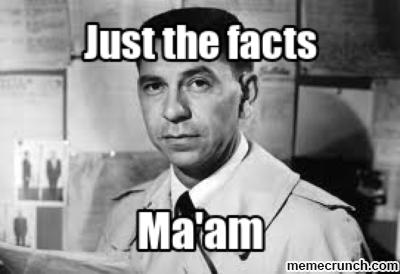26 December 2014
Jack Webb, the famed Dragnet detective, consistently called for “Just the facts, Ma’am, just the facts.” That stance, a wise one for detectives, has its counterpart among historical researchers who recognize the difference between documented “facts,” speculation, and interpretation.
Facts, viewed in isolation, do not tell a reliable story. Webb did seek unembellished facts, but he then correlated and interpreted them. As historians, we need to seek those unembellished facts also, using original and unadulterated records to every extent possible. Like Webb, we need to identify, correlate, and analyze all the evidence in order to reliably understand it. We need to pose hypotheses and test them in every conceivable way, attempting to disprove the theories we form.
When our hypotheses withstand all plausible tests, with no contrary evidence left unrebutted, we assemble our proof. At that point, it is indeed our job to put our evidence into a meaningful context that we express as an interpretation of the event or situation. Nowhere in this process, however, is there room for mere speculation.
Excerpted from Elizabeth Shown Mills, “QuickLesson 16: Speculation, Hypothesis, Interpretation & Proof,” Evidence Explained: Historical Analysis, Citation & Source Usage (http://www.evidenceexplained.com/content/quicklesson-16-speculation-hypothesis-interpretation-proof).
PHOTOCREDIT: "Just the Facts, Ma'am," Memecrunch (http://memecrunch.com/meme/2DY2W/dragnet : downloaded 4 December 2014).